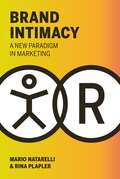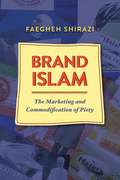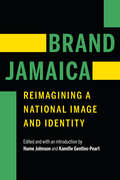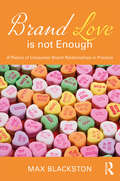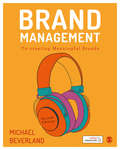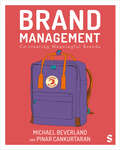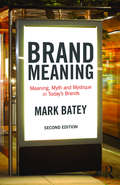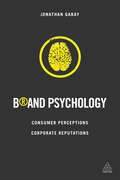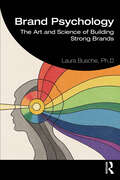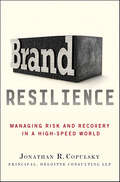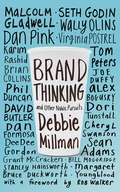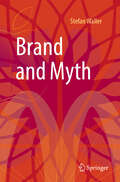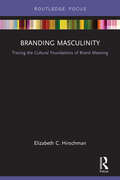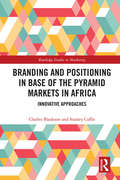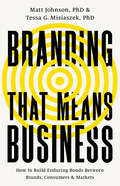- Table View
- List View
Brand Intimacy: A New Paradigm in Marketing
by Mario Natarelli Rina PlaplerFrom Patagonia to Apple, Whole Foods to New Balance, we love our favorite products--and, by extension, the companies that provide them. The emotional connections we form with our beloved brands and services are important relationships--relationships that are potentially worth billions. In the fast-paced, constantly-changing world of the modern marketplace, brands must adapt or perish—strategies, methods, and techniques must evolve to remain effective and relevant. Are you using yesterday’s thinking for tomorrow’s challenges? Brand Intimacy details ways to build better marketing through the cultivation of emotional connections between brand and consumer. The book provides lessons for marketers and business leaders alike who are seeking to understand these ultimate brand relationships and the opportunities they represent. Divided into three sections, Brand Intimacy starts with Context and Understanding. This explains today’s marketing landscape, the effects of technology, consumer behaviors and the advancements around decision making. Through research we discovered that people form relationships with brands the same way they develop relationships with other people. This section provides guidance on how to think about complimentary concepts such as loyalty, satisfaction and brand value. We then explore and compare established approaches and methodologies and showcase why intimacy is a compelling new and enhanced opportunity to build your brand or market your business. The second section, Theory and Model reveals and dimensions the brand intimacy model and dissects it into steps to help you better factor it into your marketing approaches or frameworks. Here you will learn the core concepts and components that are essential to build bonds and the role emotion can play to help you achieve greater customer engagement. You can also review the rankings of the best brands in terms of Brand Intimacy. A summary of our annual research reveals the characteristics of best performers, the most intimate industries, and differences based on geography, age, gender and income. By examining the top intimate brands, we reveal and decode the secrets of the bonds they form with their customers. The third section is Methods & Practice, this details the economic benefits and advantages of a strategy that factors Brand Intimacy. Intimate brands are proven to outperform the Fortune 500 and Standards and Poors’ index of brands. Intimate brands create more revenue and profit and last longer. Consumers are also willing to pay more for a brand they are more intimate with. Conversely, we also explore a series of brand failures and lessons learned to help you avoid common pitfalls in brand management. We articulate the steps to build a more intimate brand as well as share a glimpse on the future where software will play a more important role in brand building. The book outlines a proprietary digital platform that we use to help manage and enable intimacy through collaboration, simulators and real-time tracking of emotions. Business and marketing owners face an increasing difficult task to build brands that rise above the clutter, engage more and grow. Brand Intimacy explains how to better measure, build and manage enduring brands. Brands that are built to inspire as well as profit. Written by experienced marketers and backed by extensive research, Brand Intimacy rewrites the rulebook on how to establish and expand your marketing. The book is equal parts theory, research and practice, the result of 7 year journey and a new marketing paradigm for the modern marketer.
Brand Islam: The Marketing And Commodification Of Piety
by Faegheh ShiraziFrom food products to fashions and cosmetics to children’s toys, a wide range of commodities today are being marketed as “halal” (permitted, lawful) or “Islamic” to Muslim consumers both in the West and in Muslim-majority nations. <P><P>However, many of these products are not authentically Islamic or halal, and their producers have not necessarily created them to honor religious practice or sentiment. Instead, most “halal” commodities are profit-driven, and they exploit the rise of a new Islamic economic paradigm, “Brand Islam,” as a clever marketing tool. <P><P> Brand Islam investigates the rise of this highly lucrative marketing strategy and the resulting growth in consumer loyalty to goods and services identified as Islamic. Faegheh Shirazi explores the reasons why consumers buy Islam-branded products, including conspicuous piety or a longing to identify with a larger Muslim community, especially for those Muslims who live in Western countries, and how this phenomenon is affecting the religious, cultural, and economic lives of Muslim consumers. <P><P>She demonstrates that Brand Islam has actually enabled a new type of global networking, joining product and service sectors together in a huge conglomerate that some are referring to as the Interland. <P><P>A timely and original contribution to Muslim cultural studies, Brand Islam reveals how and why the growth of consumerism, global communications, and the Westernization of many Islamic countries are all driving the commercialization of Islam.
Brand Jamaica: Reimagining a National Image and Identity
by Kamille Gentles-Peart Hume JohnsonBrand Jamaica is an empirical look at the postindependence national image and branding project of Jamaica within the context of nation-branding practices at large. Although a tiny Caribbean island inhabited by only 2.8 million people, Jamaica commands a remarkably large presence on the world stage. Formerly a colony of Britain and shaped by centuries of slavery, violence, and plunder, today Jamaica owes its popular global standing to a massively successful troika of brands: music, sports, and destination tourism. At the same time, extensive media attention focused on its internal political civil war, mushrooming violent crime, inflation, unemployment, poverty, and abuse of human rights have led to perceptions of the country as unsafe.Brand Jamaica explores the current practices of branding Jamaica, particularly within the context of postcoloniality, reconciles the lived realities of Jamaicans with the contemporary image of Jamaica projected to the world, and deconstructs the current tourism model of sun, sand, and sea. Hume Johnson and Kamille Gentles-Peart bring together multidisciplinary perspectives that interrogate various aspects of Jamaican national identity and the dominant paradigm by which it has been shaped.
Brand Love is not Enough: A Theory of Consumer Brand Relationships in Practice
by Max BlackstonHow would you feel about a bank that handled all of your financial needs efficiently, but made you feel like a dummy? In a relationship between two people, what the other person thinks of you (or what you believe they think of you) exerts great influence on the quality of your relationship. The same is true for your relationship with brands. In this trailblazing book, Blackston extends his theory on consumer brand relationships introduced in the 1990s. He introduces a new construct called "brand's attitude," which complements the idea of brand image and introduces a typology of consumer relationships that is richer and more varied than the familiar concept of brand love. This construct describes more fully the two-way street that exists between consumers and brands, and fills a crucial gap in traditional branding literature in explaining consumers’ brand purchasing and usage behavior. Drawing on numerous actual examples and cases from a variety of different industries, and supported by 30 years of consumer data, Brand Love is not Enough should be on the shelf of any serious marketer or student of branding.
Brand Management: Co-creating Meaningful Brands
by Michael BeverlandPresenting the basics of brand management, the book provides both a theoretical and practical guide to brands, placing emphasis on the theory that the consumer is a co-creator in a brand′s identity. In a world in which social media and inclusive digital platforms have increased customer engagement, the role of brands and branding has changed. The line between the producer and the consumer has become blurred; consumers are no longer the recipients of brand identity, but the co-creators, playing a significant role in shaping new products and systems. Case studies include the Canterbury Crusaders, KVD Beauty, Kodak, Yamaha, Ottobock and Holland′s rebrand as The Netherlands.
Brand Management: Co-creating Meaningful Brands
by Michael BeverlandPresenting the basics of brand management, the book provides both a theoretical and practical guide to brands, placing emphasis on the theory that the consumer is a co-creator in a brand′s identity. In a world in which social media and inclusive digital platforms have increased customer engagement, the role of brands and branding has changed. The line between the producer and the consumer has become blurred; consumers are no longer the recipients of brand identity, but the co-creators, playing a significant role in shaping new products and systems. Case studies include the Canterbury Crusaders, KVD Beauty, Kodak, Yamaha, Ottobock and Holland′s rebrand as The Netherlands.
Brand Management: Co-creating Meaningful Brands
by Michael Beverland Pinar CankurtaranThis popular textbook introduces students to contemporary brand management and innovation with a focus on how companies and consumers are interacting and co-creating brands today. The latest edition continues to provide equal focus on theory and practice with all new case studies and examples from brands around the globe to help show the wide range and diversity of brands and consumers today. These include Glossier, Lovehoney, Whisper, Shinola Detroit, Trung Nguyen, Shatta Wale, Tony’s Chocolonely. Also included are updated research references and online resources, as well as a brand-new chapter on the creative aspects of branding from naming to logos and experiences. This textbook is essential reading for all students studying branding and brand management at university level. Michael Beverland is Professor of Brand Marketing at University of Sussex Business School. Pinar Cankurtaran is Assistant Professor of Brand Strategy at the Faculty of Industrial Design Engineering, Delft University of Technology.
Brand Management: Co-creating Meaningful Brands
by Michael Beverland Pinar CankurtaranThis popular textbook introduces students to contemporary brand management and innovation with a focus on how companies and consumers are interacting and co-creating brands today. The latest edition continues to provide equal focus on theory and practice with all new case studies and examples from brands around the globe to help show the wide range and diversity of brands and consumers today. These include Glossier, Lovehoney, Whisper, Shinola Detroit, Trung Nguyen, Shatta Wale, Tony’s Chocolonely. Also included are updated research references and online resources, as well as a brand-new chapter on the creative aspects of branding from naming to logos and experiences. This textbook is essential reading for all students studying branding and brand management at university level. Michael Beverland is Professor of Brand Marketing at University of Sussex Business School. Pinar Cankurtaran is Assistant Professor of Brand Strategy at the Faculty of Industrial Design Engineering, Delft University of Technology.
Brand Meaning: Meaning, Myth and Mystique in Today’s Brands
by Mark BateyThis second edition of Brand Meaning lays out new territory for the understanding of how brands both acquire and provide meaning. The author draws on his experience with leading international companies to propose a compelling framework for the conscious and unconscious ways in which people connect with products and brands. Revised and updated, it contains contemporary as well as classic examples of brand meaning in practice from various countries, and expands on the theory, methods and applications of brand meaning. The book’s multidisciplinary approach and concise yet comprehensive content makes it an ideal supplemental reader for undergraduate, graduate, and MBA courses, as well as valuable reading for practitioners in the fields of marketing, advertising and consumer research. For more information, visit www.brandmeaning.com.
Brand Psychology
by Jonathan GabayWhy do we trust some brands more than others? How important is integrity for a brand's survival? How can brand confidence be rebuilt during a crisis? Using both new and classic insights from social psychology, cognitive psychology and neuroscience, Brand Psychology reveals the hidden processes behind why certain brands command our loyalty, trust and - most importantly - disposable income. Reputation management authority Jonathan Gabay takes readers on a tour of the corporate, political, and personal brands whose understanding of consumer psychology has either built or broken them.Suitable for marketing, branding and PR professionals, reputation management specialists and students, Brand Psychology takes examples from e-cigarette legislation, the iPhone 5S's fingerprint ID technology, Barclays' branded bikes and the London 2012 Olympics, Miley Cyrus and the UK National Health Service's big data to reveal how to build a meaningful brand that resonates with the public.
Brand Psychology: The Art and Science of Building Strong Brands
by Laura BuscheBrand Psychology brings together theory and practice from the fields of psychology, design, and marketing to demystify the brand development process. It explores the behavioral science behind brand building, looking at the psychological principles at play whenever a brand is built and communicated. Backed by research from various fields of psychology, the book presents practical insights for developing memorable brands through its interdisciplinary character, and emphasis on digital channels. Throughout the book, readers will learn to apply concepts from brand psychology, social learning and persuasion, identity design, and sensory branding to attract and retain their ideal customers. Each chapter presents insights from academic consumer behavior studies, real-life cases from inspiring brands, and unique visual learning tools including infographics, worksheets, and timelines. Ultimately, it serves as a tool to bridge the gap between scientists and entrepreneurs, offering clear, research-backed ideas to drive brand growth and reach human beings in a meaningful way during a time of independent brands and global connectivity. This transformative book shows readers how to: Develop memorable brands that resonate with their target audience Create powerful brand stories, archetypes, and strategies for growth Navigate brand management with mindful communication and active shaping of associations Containing cutting-edge brand-building tools, this book is a must-read for students and practitioners in brand management, marketing, design management, graphic design, business, advertising, and related spaces that aim to craft an identity that turns heads and hearts.
Brand Resilience: Managing Risk and Recovery in a High-Speed World
by Jonathan R. CopulskyAs the recent Tiger Woods scandal illustrates, brand reputation is more precarious than ever before. True and false information spreads like wildfire in the vast and interconnected social media landscape and even the most venerable brands can be leveled in a flash—by disgruntled customers, competing companies, even internal sources. Here, veteran marketing executive Jonathan Copulsky shows companies and individuals how to play brand defense in the twenty-first century.Five Signs that You Need to Pay More Attention to the Possibility of Brand Sabotage:A group of uniformed employees posts embarrassing YouTube videos, in which they display unprofessional attitudes towards their work.One of your senior executives publicly blames a supplier for product defects, even though they predate your relationship with the supplier.Your competitor's ads trumpet their solution to the performance problems associated with your most recent product.A customer unhappy with changes made to your product design launches a Facebook group, which attracts 5,000 fans.Your outsource partner is prominently featured in numerous blogs and websites describing allegations of worker mistreatment and workplace safety hazards.
Brand Seduction: How Neuroscience Can Help Marketers Build Memorable Brands
by Daryl WeberAn examination of the nature of brands, how they exist and behave in the mind, and how marketers and business leaders can use this to their advantage.In Brand Seduction, author Daryl Weber reveals the latest psychological and neuroscientific discoveries about how our minds process brand information and makes decisions, and the important roles our emotions and unconscious play in our selections.Through simple language, engaging stories, and real-world examples, Brand Seduction shows you how to decode, build, and use these hidden brand fantasies to grow your brand and business.Praise for Brand Seduction“Powerful, profound, and beautifully written, Brand Seduction raises the bar for every marketer to do work that truly matters.” —Seth Godin, author of All Marketers Are Liars“Clever, creative, and jam-packed with useful insights, Brand Seduction shows how our brain secretly shapes our choices in ways we may never have realized.” —Jonah Berger, Wharton Professor and bestselling author of Contagious and Invisible Influence“With solid research and real-world examples, Daryl Weber makes the science of marketing inspiring and actionable. Brand Seduction is a valuable tool for anyone seeking to leverage the power of their brands.” —Nir Eyal, author of Hooked
Brand Society
by Martin KornbergerBrands are a fait accompli: they represent a mountain range of evidence in search of a theory. They are much exploited, but little explored. In this book, Martin Kornberger sets out to rectify the ratio between exploiting and exploring through sketching out a theory of the Brand Society. Most attempts to explain the role of brands focus on brands either as marketing and management tools (business perspective) or a symptoms of consumerism (sociological perspective). Brand Society combines these perspectives to show how brands have the power to transform both the organizations that develop them and the lifestyles of the individuals who consume them. This holistic approach shows how brands function as a medium between producers and consumers in a way that is rapidly transforming our economy and society. That's the bottom line of the Brand Society: brands are a new way of organizing production and managing consumption. Using an array of practical case studies from a diverse set of organizations, this book provides a fascinating account of the way in which brands influence the lives of individuals and the organizations they work in.
Brand Thinking and Other Noble Pursuits: Insights And Provocations From World-renowned Brand Consultants, Thought Leaders Designers, And Strategists
by Debbie Millman Rob WalkerWe are now living in a world with over one hundred brands of bottled water. The United States alone is home to over 45,000 shopping malls. And there are more than 19 million customized beverage choices a barista can whip up at your local Starbucks. Whether it’s good or bad, the real question is why we behave this way in the first place. Why do we telegraph our affiliations or our beliefs with symbols, signs, and codes?Brand Thinking and Other Noble Pursuits contains twenty interviews with the world’s leading designers and thinkers in branding. The interviews contain spirited views on how and why humans have branded the world around us, and the ideas, inventions, and insight inherent in the search.
Brand and Myth
by Stefan WallerBrand and Myth A Cultural-Philosophical Consideration Brands reflect the desires of the modern individual. In Nike, it’s the hope of achieving success by simply doing it; in a Mercedes, it’s the pursuit of status; and in a MasterCard, it encapsulates the longing for those moments that cannot be bought with money (but for which you still need money). The list can go on for a long time. Despite the fact that these brand messages are understood across various cultures, they have played a secondary role in cultural-philosophical debates. To professional thinkers, brands appear, at best, as banal and, at worst, as instruments in a malign illusionary context. They are seen as expressions of capitalism, something to be viewed critically, and thus rejected. From a more neutral standpoint, the engagement with brands is understood as a subject of business administration, marketing, and design, and therefore considered outside of one’s own area of expertise.
Brand, Label, and Product Intelligence: Second International Conference, COBLI 2021 (Springer Proceedings in Business and Economics)
by Joseph Kaswengi Aurore IngaraoThis book contains the latest and most up-to-date research results from the fields of brands, labels and product, presented at the international colloquium COBLI 2021, held in Orleans, France. It covers a wide range of topics from the fields of economics, psychology, information technology and social sciences. In particular, the book deals with various areas of application such as consumer behavior in the omnichannel, the influence of the coronavirus pandemic on attitudes and customer behavior, franchising, origin labelling, transparency in the agri-food industry, tourism and the triptych of brand/label/product. The contributions are gathered under the following main topics: Consumer behavior and decisions, labeling strategy, brand market trends, branding of local brands, territorial impact on brand/label/product, theoretical and managerial research methods.
Branded Content and Entertainment in Advertising: A Theoretical and Empirical Study of Creative Advertising Practices (Routledge Studies in Marketing)
by María Rodríguez-Rabadán BenitoIn recent years, branded content and entertainment have become standard practice for brands, advertising agencies, and production companies. This volume analyzes branded content through a theoretical and empirical study to examine the factors that have led to exponential growth and the adaptation of creative advertising processes in the creation of branded content. The book debates the suitability and acceptability of branded entertainment as an advertising practice, the different degrees of involvement of the brand in creating content, and the brands' mastery of entertainment. It explores the implications that may underpin the practice and discusses the necessary creative elements involved in their successful execution, as well as the effects it has on consumers and audiences. This insightful book will be a valuable guide for academics and upper-level students across marketing disciplines, including advertising, brand management and communications, as well as screenwriting.
Branding Bangladesh: From ‘Bottomless Pit’ to a ‘Middle Income’ Country
by Imtiaz A. Hussain Jessica Tartila SumaThis book explores Bangladesh's shift from a 'bottomless pit' into a 'middle-income' category. Six chapters in the book cover topics on microfinance growth, ready-made garment production, and social safety net programs playing pivotal roles particularly for women empowerment. In doing so, the book shows that the net effect was not just a change to the country's limited number of representative brands, but also a realization of many more brands to have built up over time.
Branding Cities: Cosmopolitanism, Parochialism, and Social Change (Routledge Advances in Geography)
by Stephanie Hemelryk Donald Eleonore Kofman Catherine KevinFierce competitiveness between established and emerging major cities, such as Berlin, London, Shanghai and Sydney, has led to a pressure to excel as desirable locations for business, cultural activities, highly skilled migrants and tourists. At the same time, the transformation of settled and new migrant communities creates complex urban borders and variegated representations (academic, cinematic, popular, official) of the city. While cities increasingly deploy cosmopolitan images portraying the diversity of past and present populations and activities, this continues to coexist with parochialism as a mood and mode of cultural formations and a reflection of local specificities. This volume brings together cultural analysts, social scientists, and media and film scholars to explore the ways in which core cities generate competing claims on, and visions of, their use and their future, and thus have engaged with the necessity to brand their image for international consumption and for internal coherence.
Branding Masculinity: Tracing the Cultural Foundations of Brand Meaning (Routledge Interpretive Marketing Research)
by Elizabeth C. HirschmanBranding Masculinity examines two ideologies of masculinity – one typifying rural agricultural areas and the other found in urban, business settings. Comparisons are made between these two current forms of masculinity and both similarities and differences are identified. Six product categories compose the Constellation of Masculinity for both groups. Hirschman selects a masculine prototype brand from each category and presents a detailed analysis of the images, language and marketing actions used to create the brand's masculinity over time. Using her method, marketers for other brands will be equipped to enhance the masculine status of their brands, as well. Branding Masculinity proposes that masculine brands are made, not born. Masculinity is an enduring cultural ideal which can be attached to a variety of products and brands by the appropriate use of symbols, icons and images. Scholars from various disciplines within the fields of branding, marketing, public relations and corporate identity will see this book as vital in continuing the academic discourse in the field. It will serve as a respected reference resource for researchers, academics, students and policy makers, alike.
Branding New York: How a City in Crisis Was Sold to the World
by Miriam GreenbergWinner of the 2009 Robert Park Book Award for best Community and Urban Sociology book! Branding New York traces the rise of New York City as a brand and the resultant transformation of urban politics and public life. Greenberg addresses the role of "image" in urban history, showing who produces brands and how, and demonstrates the enormous consequences of branding. She shows that the branding of New York was not simply a marketing tool; rather it was a political strategy meant to legitimatize market-based solutions over social objectives.
Branding Texas
by Leigh ClemonsAsk anyone to name an archetypal Texan, and you're likely to get a larger-than-life character from film or television (say John Wayne's Davy Crockett or J. R. Ewing of TV's Dallas) or a politician with that certain swagger (think LBJ or George W. Bush). That all of these figures are white and male and bursting with self-confidence is no accident, asserts Leigh Clemons. In this thoughtful study of what makes a "Texan," she reveals how Texan identity grew out of the history--and, even more, the myth--of the heroic deeds performed by Anglo men during the Texas Revolution and the years of the Republic and how this identity is constructed and maintained by theatre and other representational practices. Clemons looks at a wide range of venues in which "Texanness" is performed, including historic sites such as the Alamo, the battlefield at Goliad, and the San Jacinto Monument; museums such as the Bob Bullock Texas State History Museum; seasonal outdoor dramas such as Texas! at Palo Duro Canyon; films such as John Wayne's The Alamo and the IMAX's Alamo: The Price of Freedom; plays and TV shows such as the Tuna trilogy, Dallas, and King of the Hill; and the Cavalcade of Texas performance at the 1936 Texas Centennial. She persuasively demonstrates that these performances have created a Texan identity that has become a brand, a commodity that can be sold to the public and even manipulated for political purposes.
Branding and Positioning in Base of the Pyramid Markets in Africa: Innovative Approaches (Routledge Studies in Marketing)
by Charles Blankson Stanley CoffieBrand management to sustain corporate reputation and customer loyalty is essential for both multinationals and indigenous fi rms in Africa. This book provides a practical overview of country branding and positioning activities in Africa, based on a broad defi nition of base of the pyramid (BoP) marketing, which includes both goods and services, as well as business-to-business marketing, corporate branding, and country branding. The text highlights branding strategies that can be adopted in BoP markets, as well as marketing mix strategies appropriate for much of the continent. Taking into account the role of social networks, culture, and religion, the book explores avenues for developing and building competitive advantage, and how African countries can leverage country branding as part of the development process. The book is ideal for researchers, educators and advanced students in international marketing, management, and brand strategy who are interested in the unique branding characteristics of the African continent.
Branding that Means Business: How to Build Enduring Bonds between Brands, Consumers and Markets
by Matt Johnson Tessa G MisiaszekA revelatory guide on how to build, sustain and grow a brand. A brand is either beloved, or it&’s noise. We live in a fast-paced world of immediate gratification where consumers can listen to any song, watch any movie, or read any article, with the touch of a few buttons. They are peppered with hyper-personalized targeting for products that can be ordered seamlessly and arrive within hours. And if your brand isn&’t the first to come to mind, they&’ll click that button and it&’ll be delivered by someone else. So how do you make sure your brand connects with consumers? Branding that Means Business draws from the authors&’ experience and business literature as well as psychology, sociology, and even anthropology to show readers that while any brand serves the business, the mechanisms that enable it are all about connecting with people. Readers will learn how to create, maintain, and operationalize their brand, and think creatively about how to differentiate their product and most importantly, make consumers fall in love with it.
